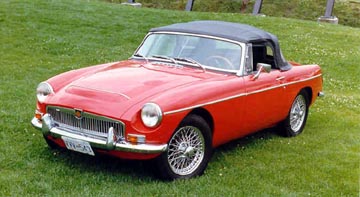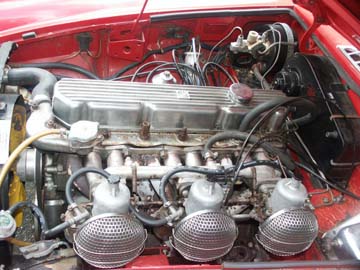Love it. Sheer awesomeness!!


Photography by Zachary Mayne
[Editor's Note: This article originally appeared in the July 2011 issue of Classic Motorsports.]
When it comes to great classic cars, there are a few so rare that the only possible way to experience one is with a recreation. Among those is the MGC GT Sebring.
How rare, exactly, is this model? According to the history books, originally five (some say six) chassis were destined to be turned into full-on race cars by the BMC Competitions Department in 1967. If that number weren’t small enough, only two fully functioning cars were ever officially produced and raced.
The pair—carrying license plates MBL 546E and RMO 699F—went on to race promisingly at storied venues such as the Targa Florio, the Nürburgring and, of course, the eponymous 1968 Sebring, where a GTS won its class. Unfortunately, what could have been an illustrious career for the cars was cut short. The Competition Department shuttered its doors in 1969 after MG was acquired by British Leyland.
Obviously, anyone who wants an original Sebring is pretty much out of luck. The alternative, of course, is building or buying a recreation.
Like many MG fans—and car enthusiasts in general—Southern Californian Steve Simmons has always had a special place for the MGC GTS on his list of must-have cars.

Steve’s MG passion isn’t limited to the later cars. He’s also got a square-rigged T-series.
If ever there were an enthusiast who should own a dead-on MGC tribute, it would be this dyed-in-the wool MG nut. Steve’s passion for cars bearing the MG badge is the result of an automotive family heirloom. “I spent much of my youth riding around in my father’s 1965 MGB,” says Steve. “He got it from his father, and after he drove the car daily for over a decade, it eventually became my problem.”
That MGB became Steve’s first car, and he still has it. It’s one of five MGs currently in his stable.
His garage is stuffed to the rafters with two lifts containing a 1949 MG TC, a 1958 MGA roadster, a 1965 MGB roadster, the aforementioned ’67 MGB and, of course, the Sebring. And get this: He still uses the ’67 MB GT as a daily driver despite the grind of Los Angeles traffic.
Steve may be borderline masochistic, but using the GT as a commuter car makes him a hero. “I’ve never owned a more practical and fun car, and it’s no less reliable than most of the newer cars I’ve owned,” he adds. “More than likely, I’ll never own another modern car.”
Owning a Sebring recreation was high on Steve’s bucket list, and he was actually familiar with this particular MGC long before he became its owner. “The first time I saw XRX was on a club outing,” he explains, referring to the car by its number plate. “The then-current owner had just acquired the car and was just getting a feel for it.”
MG Motorsports, an English tuner shop, had recently built the MGC into a pretty wild beast before it sold to an American enthusiast and was shipped to these shores. To say that Steve was smitten by the lavishly flared, bright-red MGC is an understatement. He never forgot about it.
“Several years later, I heard it was for sale and saw a few photos taken at a local car gathering,” he recalls, adding that he was awfully tempted to buy it. He already had a garage full of MG projects, though, and after struggling with the decision, he managed to put the Sebring out of his mind. It must have been fated for him to own the car, though, since it kept popping up on his radar, tempting him with its hard-to-miss hue, ostentatious stance and throaty straight-six engine.
A couple of months later, he found out it was still for sale. “Apparently the seller was not very motivated and was looking for the ‘right’ buyer,” Steve continues. “It took me over a month to muster the courage to look at the car in person.” The last thing he wanted to do was make an impulse purchase of another vintage automobile. Even so, he was fully aware that experiencing his dream car firsthand would make it impossible for him to pass up—no matter what the logical side of his brain was droning on about.
“It was too late because the car had already gotten beneath my skin,” he admits. The seller thought he was the ideal buyer, too. “A week later it was in my garage,” Steve sighs. “Despite the drop in my bank account, I never regretted the decision I made that afternoon.”
With the car is his possession, Steve could study the details of this meticulously faithful recreation. Before its rebirth, it was just a 100,000-plus-mile ’69 MGC GT that had undergone a few color changes throughout its life. MG Motorsports has since converted the car to Sebring specifications while performing a nut-and-bolt restoration.
The exterior of the car is modified with GTS-style fiberglass fender flares—the defining visual signature of this competition model—which allow for a far larger wheel-and-tire package. Up front is a hand-rolled aluminum valance.
The standard MGC radiator is augmented by a 10-row oil cooler mounted behind the front valance.
The hood is a lightweight aluminum piece with a power bulge to clear the six-cylinder engine; it’s secured with an evocative leather strap. Riveted-on Sebring headlight covers, a massive exterior fuel filler, dual Lucas fog lights and large brake-cooling ducts complete the look.
The MGC has undergone some cosmetic surgery since Steve’s purchase, however. “In 2008 the car went to a high-end restoration shop for a full body and paint makeover,” he says. The body was repainted in the correct Tartan Red—a traditional Works MG color—with white number plates on the doors, hood and hatch.
Most run-of-the-mill Sebring replicas are powered by a hotter MG four-cylinder engine; V6 or even V8 transplants are common as well. This, however, is no run-of-the-mill job. Under that alloy hood is the proper, genuine 3.0-liter MG straight six, an engine that can easily make a Triumph TR6’s 2.5-liter powerplant tremble in its Strombergs.
Pop the hood of Steve Simmons’s MGC Sebring replica and you’ll find the right equipment: the inline six that helped differentiate the MGC from the similar MGB.
The engine was rebuilt shortly before Steve acquired the car and has not needed much in the way of mechanical maintenance. The aluminum head is gas-flowed for optimal performance and works with a re-profiled cam. High-lift rockers and an adjustable vernier cam gear delivers precise cam timing to the higher-lift camshaft.
The engine also sports a lightened flywheel that allows the motor to rev more quickly. On the fuel side of things, a trio of massive 45DCOE Weber carbs are mated to an alloy intake manifold. Steve figures that the 3.0-liter engine is producing around 200 horsepower—about twice what it put out originally.
No narrow wires here. Center-lock hubs secure 15x8-inch Compomotive alloys that wear sticky Dunlop Formula R D84 tires measuring 205/60R15.
A Downton-style header feeds into a dual 1.75-inch exhaust that terminates with two 24-inch glass-pack mufflers. “I have to admit that the sound of this car is intoxicating,” Steve says during a spirited drive on the winding roads that crisscross the Malibu hills just above the Pacific Ocean.
“Sometimes I have to restrain myself from acting like a 16-year-old by flooring it just to hear the exhaust roar,” he continues. “There is nothing like the feel and sound of a heavy-breathing straight-six engine. You can actually hear the air being sucked into the carburetors over the engine.”
In order to keep all that power safely harnessed, the suspension and brakes have been appropriately beefed up. The front torsion bars are larger, and the original front shock absorbers have been replaced with Spax adjustable units. There’s also a quick-ratio steering rack, while the suspension alignment has been tweaked for quite a bit of negative camber.
Inside, the MGC strays from its competition inspiration in order to remain useable for street driving. The seats are original MGC GT spec, but they’ve been redone with black leather and red piping. Wilton wool carpeting adds comfort, while a 15-inch Works-style MotoLita wheel and wrinkle-painted roll bar add a dash of race flavor.
Steve’s MGC recreation is about as cool as it gets when it comes to this particular marque. Despite its ferocious transformation, it recalls a time when things were more basic and straightforward.
“Other than nostalgia, I think what attracts me to MGs is in no small part their simplicity and raw motoring experience,” he says. “Throughout history these cars have offered a no-frills, in-your-face ride, from the first models in the 1920s through the incredible racing successes of the ’30s and right into the late ’60s. After that, most cars lost me. The older and more pure they are, the more I love them.”
I happen to be the second owner of RMO699F in the U.S. in the early 70's.
If anyone is interested in getting the real info on that particular historic car, contact me and I will forward photos and a small historical document.
I had seen this article before. Really great.

In reply to Silver912 :
Hi there. Saw your post ref RMO. I'm in the throws of rebuilding my MGC to RMO spec. It's a 69 MGC which has had a lot of work done to it over the years, all the usual Doug Smith and Downton upgrades. Bodywork and chassis are now back up to scratch. Engine is a stage 2 with triple webbers which has also been stripped down and refreshed. Now looking to make the structural changes. I have a copy of "The MGC Lightweights" by David Morys. Great reference book, but I could do with more reference pictures if the internals - boot area, battery set up, as well as general pictures and history to help us on the way? Interested to hear too your story on how you acquired the car and what work you carried out? Cheers!
In reply to Silver912 :
Very cool.
I own a 1968 C GT. I would love to learn more about RMO-699F
We owned an MGC for many years. I modified the engine (original puts out maybe 130 bhp although they claimed 145 bhp).
I created a triple SU manifold (Webers are overkill for a street car unless it is just for the car show bling) and it turns the into what the factory should have produced (mine was c 175 bhp and topped out at 130 mph+). The few very specially modified factory cars encouraged quite a few replicas, some of them quite faithful to the original. Great cars and so sad that they wee summarily killed by the new Triumph heavy take-over administration, who wanted no competition for the TR6.
The owners of the few real RMO cars were very lucky guys!


Hello there, sorry about the long silence, I was hoping that I would get an email alert about your inquiries.
Here is a very interesting article, half way down the pdf.
https://www.mgcc.co.uk/mgc-register/wp-content/uploads/sites/24/2020/01/26-MGC-Newsletter-Dec-19.pdf
I will add some more items soon.




Displaying 1-8 of 8 commentsView all comments on the CMS forums
You'll need to log in to post.